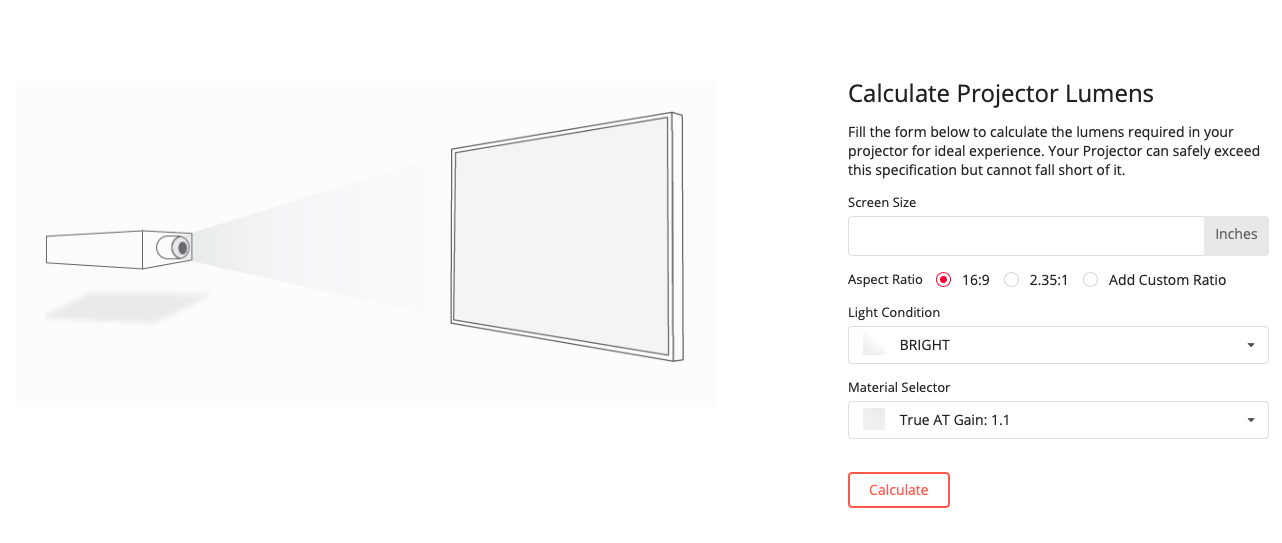Buying A Projection Screen
An Easy 6 Step Guide with a downloadable worksheet
Choosing the right projection screen can be a pain with all the choices. But it doesn't have to be hard. Here's a simple 6-step guide to buy the best projection screen for your home or office. There's a downloadable worksheet at the end of this post.
The 6 Steps
- 1Decide Aspect Ratio
- 2Measure Room Dimensions
- 3Decide Ambient Light Level
- 4Calculate Screen Size
- 5Decide between Fixed-Frame Or Retractable type screens?
- 6Rate Screen Options
1. Decide Aspect Ratio

A wider aspect ratio reveals more details
Aspect Ratio is the proportion of width to height of the content you watch. As you can see in the illustration, it changes the number of details that you see in the picture.
For TV, it is 16:9, the movie you watch at the cinemas is 2.35:1. So, decide on your favourite content to decide your aspect ratio. I'm listing down the aspect ratios for popular content formats to help you decide. A pretty safe option is go for 16:9 as all projectors and distribution formats (Blue-Ray discs, Netflix, Prime) support this universally. If you already have a projector, find this value in the specifications.
Below is a list of popular content types and their aspect ratios.
For TV, it is 16:9, the movie you watch at the cinemas is 2.35:1. So, decide on your favourite content to decide your aspect ratio. I'm listing down the aspect ratios for popular content formats to help you decide. A pretty safe option is go for 16:9 as all projectors and distribution formats (Blue-Ray discs, Netflix, Prime) support this universally. If you already have a projector, find this value in the specifications.
Below is a list of popular content types and their aspect ratios.
2. Measure Room Dimensions
Measure the height and width for the wall on which you plan to hang the screen. Also measure the distance from the screen to one ideal viewer location in the room.

3. Decide Ambient Light Level
If it's not pre-fixed, make a choice for how much light you plan to have in the room - Bright / Moderate / Dark?
4. Calculate Screen Size
Go to Size Calculator on ARETE Screens website and plug in the required details to get the ideal screen size for your room.
5. Decide Fixed-Frame Or Retractable Type
A fixed frame screen is setup once and remains there but a retractable screen is pulled down only when being used and stays hidden otherwise. Most serious Home Cinema installations are done with fixed frame screens. You can make this choice considering available space and other constraints.
6. Evaluate your screen options
Now make a list of available screen options for your size and aspect ratio and rate them on a scale of 1 - 5, 5 being the best, on these three criteria.
Something like this table
- Build Quality - Is it all metal, or wood or plastic? Some materials like velvet are known to catch dust. Watch out for those too.
- Design - Do you like a thin bezel or a thick bezel? Flat or Curved? Curved screens can distort your image a little so notice that. Also, does the overall design match your interiors and taste?
- Picture Quality - How good is the colour and contrast? Some materials are better suited for brightly lit environments. If you have speakers behind the screen in your installation, you need an Acoustically Transparent fabric
Something like this table
Screen Model
Material/Gain
Build Quality
(Rate 1-5)
(Rate 1-5)
Design
(Rate 1-5)
(Rate 1-5)
Picture Quality
(Rate 1-5)
(Rate 1-5)
Sum up score for each row and write the total in the final column. Pick the screen that gets the highest score.
Let's Make It Easier
Arete Screens Privacy Policy

Get this easy-to-follow worksheet by filling in this form
7. (Bonus) Find the ideal projector brightness for your screen
Open the Lumens Calculator on ARETE Screens website and enter the details to get ideal projector brightness for your screen
At Arete Screens, we're passionate about projection screens. Our products are designed to delight you, the customer, for years. Please ask us for advice and we'll be happy to help. Did we miss anything important? Please share in comments.
www.aretescreens.com
www.aretescreens.com


